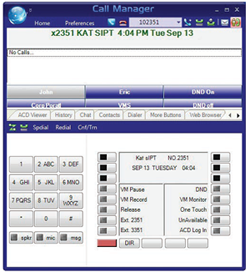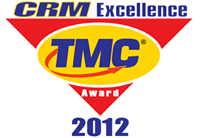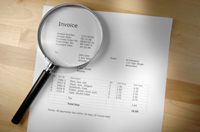7 Ways to Get More Done with Fewer People

Kelly Scanlon, owner of Thinking Bigger Business Media, Inc. is a respected
advocate for small business owners. She knows entrepreneurs and what's on their
minds.
In a recent post on Linked-In, Kelly asked the question, "If you are a business
owner whose business is growing but you haven't been hiring, what methods, techniques
or strategies are [you] using to get the additional work done?"
Kelly, we're glad you asked. We use unified communications (UC) to increase productivity
and organization so COMMWORLD can get more done with fewer people. Combine the capabilities
of the computer and telephone into one powerful communication tool. This technology
helps us offer a higher level of customer service. It's technology with a personal
touch.
Here are 7 ways UC can help you get more done with fewer people. . .
Benefits of the Toshiba Call Manager, a unified communications application, include:
- Drag and drop makes functions faster and easier. Dial, answer or
transfer calls, and more, using your mouse without ever picking up the phone. Outbound
dialing from any application makes calling easy with a click of the mouse. Let's
say you find a phone number on a website or in a document. Just highlight the number
and click to dial.
- Eliminate wasted time searching for a co-worker only to find out he/she
is gone. Presence capabilities let users see the availability of co-workers
and quickly transfer calls and important information to serve your customers faster
and better.
- Coach sales reps while they're on a call with a customer. Chat
enables instant communications with any user or broadcast a message to multiple
users.
- Certain events, conditions, and actions can trigger the way incoming calls
are handled. Routing and screening of calls, selective call forwarding,
screen pops of your customer database, voice mail notification, and more can be
changed based on your parameters.
- Stop frustrating your customers by asking them to re-answer the same questions
over and over. Notes taken by one person will follow the call wherever
it's transferred.
- Don't waste time searching for a phone number. Call history provides
a log of incoming and outgoing calls that you can print, search, sort, and redial
with one click.
- Quit shuffling papers to find the information needed to help your customer.
Instead, launch electronic documents, applications and web pages directly from
the UC interface for quick access to frequently used tools, scripts, etc.
Call Manager Unified Communications application can do all this and more. Intuitive
design and a familiar look make it easy to use and manage. Call Manager can even
be used as a stand-alone IP soft phone providing mobility and remote access so you
can work efficiently from anywhere.
Call Manager Wins 2012 CRM Excellence Award

Toshiba's Call Manager for IPedge™ has won another award!
It just received a 2012 CRM (Customer Relations Management) Excellence Award from
Customer Interaction Solutions Magazine. Call Manager was heralded for "improving
the processes... of businesses, streamlining and facilitating the flow of information
needed for companies to retain customers." This is the third award won by Call Manager
for IPedge™ since it was introduced late last summer.
Call Manager for Toshiba's digital systems is also an award winning industry leader.
Contest Ends – We Need Your Vote
Please, vote to help Crossroads Hospice of Kansas City win a new Toshiba phone system
in the Phone-a-Saurus contest. Their video made it to the final three. View the video and be sure to vote by May 31st.
The FCC adopts new rules aimed to stop cramming...

Cramming is the placement of unauthorized charges on telephone bills. On April 27,
2012, the FCC adopted new rules to help stop cramming. These aren't the first steps
taken by the FCC and the Chairman indicates they won't be the last in their efforts
to end this multi-billion dollar problem that could be costing you.
In a written statement, Chairman Julius Genachowski says that cramming costs consumers,
government and businesses billions of dollars annually. He cites the owner of several
Krispy Kreme franchises who was hit with $4000 in fraudulent charges. We took our
eye off the ball for a while and COMMWORLD of Kansas City was hit
with $252 in fraudulent charges. We've uncovered a lot of cramming through the Phone
Bill Analysis service we offer to KC businesses. In 2011, the FCC issued forfeitures
totaling over $11.5 million against four crammers.
For your protection. . .
The new rules will require carriers to notify consumers if they have the ability
to block third party charges and they will require carriers to separate non-telecom
third party charges from regular charges to make them easier to identify.
If your local / long distance / internet bill(s) total $400 or more, COMMWORLD
will conduct a bill analysis for your business – at no charge. All we need is a
copy of your bill(s) for one month and we'll do the rest.
Cramming is only one of the problems COMMWORLD uncovers when we
analyze local / long distance / internet bills. Our experts have found errors, charges
for services not in use, and out-dated or poorly designed plans resulting in many
thousands of dollars in savings.
"A 5% reduction in operating costs has the same P&L impact as a 30% increase
in sales." . . .
The Gartner Group
Check out COMMWORLD's Blog

Old shoes lead to 7 lessons on ergonomics
The cap on the heel of my shoe came off and the rough edge caught on the carpet.
So I went tumbling down the steps at home.
Bob and I have been cleaning out the last of my Dad's things so the old house could
go on the market. We have lifted and lugged enough heavy furniture, boxes and "old
stuff" to fill a 16 ft. rental truck once and our pick-up 3 times.
Read More»
50% Discount on Toshiba IP Phones

with a new, award-winning IPedge™ Communications System
Sure you can make calls on your old business phone system, but will it save money,
increase productivity, grow sales, enhance company image and improve customer satisfaction?
Toshiba's new, award-winning IPedge - VoIP (voice over internet protocol)
communications system can do all that! Contact us at 816-763-1100 or
info@commworld-kc.com to schedule a "test drive" to see what the IPedge
can do for your business.
Let COMMWORLD put our 30 years of experience and expertise to work
for you. Other companies just sell phone systems. We'll design solutions for your
challenges and install technology that improves your business and gets the results
you want.
For more about IPedge
Fun Phone Facts

By the middle of the 19th century, the Western Union Company had acquired smaller
telegraph systems in the United States and controlled the first national communications
chain. That success created a problem. Western Union engineers were working to solve
the problem of transmitting many Morse-code messages simultaneously over the same
wires.
Alexander Graham Bell, who was then on staff at the Boston School for the Deaf,
became intrigued. He met Gardner Greene Hubbard, a Boston attorney. Hubbard was
interested in the potential financial return that a solution to this problem would
bring. He agreed to provide the funds for Bell to conduct research on an invention
to improve the transmission of the telegraph.
This "harmonic telegraph" was the concept which Bell set out to invent. Thomas A.
Watson joined him in his research, but an accidental discovery during their experiments
led Bell to the idea of transmitting voice instead of Morse-code. He asked Hubbard
for permission to change the direction of his research toward speech transmission,
but Hubbard did not see any economic benefit to a speech machine and he refused.
Despite Hubbard's refusal, Bell continued following the new direction. Bell's records
show that he slanted his work toward the transmission of voice under the guise of
solving the telegraph problem. For that reason when the patent for the first telephone
was issued on March 7, 1876, it was called the "harmonic telegraph".
Source: Massachusetts Institute of Technology http://www.mit.edu/





